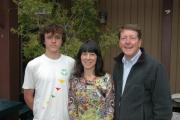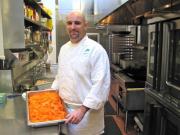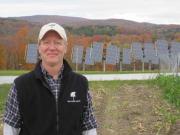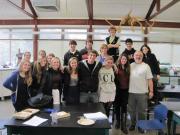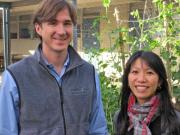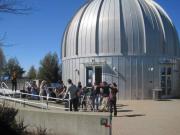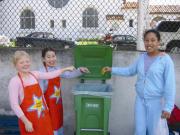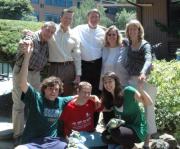Green Schools: The South
Green School Visits—The South
My visits to schools in the "south" includes several in Washington DC. Here they are in order visited: 1. St. Stephen's and St. Agnes School, 2. Sidwell Friends School, 3. Charlotte Country Day School
1. St. Stephen’s and St. Agnes School: Environmental Awakening
Just days before I visited St. Stephen’s and St. Agnes School (SSSAS), an Episcopal co-ed day school of 1100 students in Alexandria, Virginia, in mid-November, the school had finished hosting its third annual Students for Sustainability conference, or S4S, which the Washington Post called an “environmental awakening.” The gathering, which drew students from all over Washington DC, Maryland and Virginia, featured presentations on topics from the importance of beekeeping to solar power and from composting to electric cars. The event symbolizes the key critical role of students can play in the greening of a school.
Change has come swiftly to SSSAS. As School Head Joan Ogilvy Holden observed, when the school developed its most recent strategic plan in 2005, environmental sustainability was not on the horizon. Quickly, however, it became apparent that the school needed to embrace the effort to become greener, and the strategic plan was amended to embrace “sustainability in all aspects of school life. In order for students to succeed in a complex and changing world, the focus is on helping students to understand how and why the natural world is changing and the human role in those changes.” Moving ahead boldly, Holden accepted a proposal from science teacher Amanda Beckrich, created a new position of Sustainability Coordinator for her, and established an Environmental Sustainability Committee. In the subsequent five years, SSSAS has begun to integrate sustainability throughout all aspects of the school, including the academic program, professional development, clubs, and facilities. After the completion of an in-depth audit of the school’s energy use, SSSAS has embarked on a systematic efficiency campaign and has established an ambitious goal to “reduce our carbon footprint by 80% by 2020.”
In the emerging environmental movement in schools, sustaining momentum is a critical challenge. When the founding Sustainability Director left SSSAS for a year abroad with her family, the school conducted a search, and they found their next leader right in their own history department. Jillian Joyce developed a love of nature growing up in rural Vermont, tending animals on their land, joining the 4H club in school, and hiking in the Adirondacks with her father. After her education at Deerfield and Dartmouth, that included courses in environmental science, she joined the faculty of the Kingswood-Oxford School and was inspired by the school’s service learning program in Paraguay, and then she taught at the Burr and Burton School in Vermont, helping them develop a plan for a new “mountain campus.” At SSSAS she is especially proud of the school’s Perkins Courtyard, an interior space the students have transformed into a garden and native plant sanctuary the provides produce for the lunch program and a beautiful place for students the gather.
Jillian Joyce developed a love of nature growing up in rural Vermont, tending animals on their land, joining the 4H club in school, and hiking in the Adirondacks with her father. After her education at Deerfield and Dartmouth, that included courses in environmental science, she joined the faculty of the Kingswood-Oxford School and was inspired by the school’s service learning program in Paraguay, and then she taught at the Burr and Burton School in Vermont, helping them develop a plan for a new “mountain campus.” At SSSAS she is especially proud of the school’s Perkins Courtyard, an interior space the students have transformed into a garden and native plant sanctuary the provides produce for the lunch program and a beautiful place for students the gather.  She has worked to nurture students clubs in each of the school’s three divisions, and with the Upper School Environmental Club advisor Joyce Ames she has encouraged student projects from recycling and energy audits to assemblies and the annual Chapel service on the environment. Joyce sees her role as a “resource for stakeholders” and a “sustainability teacher holding up the environmental lens to all that is done at school.”
She has worked to nurture students clubs in each of the school’s three divisions, and with the Upper School Environmental Club advisor Joyce Ames she has encouraged student projects from recycling and energy audits to assemblies and the annual Chapel service on the environment. Joyce sees her role as a “resource for stakeholders” and a “sustainability teacher holding up the environmental lens to all that is done at school.”
And she believes in the power of small steps that lead to greater change.
With its focus on students, and as a religious school, it seems natural for SSSAS to nurture the students’ reverence for the earth. As Head of School Holden observed, “we aim to foster respect among our students, for each other, for the planet and its resources; it’s at the heart of what we do.”
2. Sidwell Friends School: The Greenest School in the World
Bruce Stewart and Tom Farquhar, past and present heads of the Sidwell Friends School, a coed, independent day school of 1100 students in Washington DC, speak with great enthusiasm about the bold moves their school has made toward a vision of environmental sustainability. 
When the Board of Sidwell Friends embarked upon a much-needed effort to improve the school’s facilities in 2002, environmental sustainability was not in the school’s vocabulary. After Jon McBride, a new member of the Board, saw the documentary film he Next Industrial Revolution,” by the environmentalist Bill McDonough, he was convinced the school needed to embrace sustainability as part of its efforts. Then head Bruce Stewart had challenged the Board to consider “what should we be teaching kids that is relevant to their lives in 2018.” For McBride the answer was clear: “our facilities needed to model how to get into right relationship with the natural world.” Embarking on a “field trip” to Oberlin College, they visited the environmental science professor David Orr and came back convinced that Sidwell needed to embrace the goal of building a LEED (Leadership in Energy and Environmental Design) certified building, a system of rating the relative environmental impact of buildings that then was in its early stages of being incorporated in the architectural process.
Stewart and McBride convinced the board to embrace the goal of “greening the campus.” Their first project, the Bruce Stewart and Andra Juris Middle School Building, was inaugurated in 2007 as the nation’s first LEED platinum building. Since then, the school has completed a new Lower School building, a new athletic center,
In the fall of 2010, when Tom Farquhar returned to Sidwell as the new Head of School, having spent the decade of the 1980s there as a teacher and administrator, he brought passion for the school’s commitment to environmental sustainability. After graduating from Earlham College, looking for his first job, and inspired by the idealism of the seventies and E.F. Shumaker’s book, Small is Beautiful, he convinced the head of Sandy Springs Friends School to hire him as the school’s gardener for $25 a week. At two other schools he headed, 
With the rebuilding of the campus almost complete, 
3. Charlotte Country Day School: Team Planning for Sustainability
When Mark Reed arrived at Charlotte Country Day School, a co-ed independent day school of 1600 students on two campuses, as the new Head of School in July 2009, the second person he met was Chris Gawle, the Chair of the Environmental Stewardship Committee and the Upper School Sustainability Coordinator and a leader of the environmental efforts at the school. 
The school had recently crafted an environmental mission statement to "empower our students to address social, environmental, and global issues." We provide, they note, “educational experiences designed to motivate students to participate in and initiate sustainable practices. Our goal is to create an environmentally literate and responsible community of students, faculty, staff, and families.” The school is committed to promoting sustainable practices in the following areas: Curriculum development, Resource use and recycling, Energy use and efficiency, Building construction and operation, Land management, and Food and Custodial Services. And the school has a good list of accomplishments, including everything from being the first North Carolina school to join the Green Schools Alliance to the formation of student-led Environmental Clubs in Lower, Middle, and Upper School.
For Mark Reed, it became apparent that “we needed to speak with one voice” and that the many initiatives underway in the school’s three divisions needed to be “harmonized.” With a generous grant from a member of the Board of Trustees, he was able to commission a school-wide environmental sustainability audit, conducted by the Refresco Company led by two of the school’s alumni. Given the continued recession, he decided to
Importantly, the sustainability effort at CCDS is embraced by many faculty. Director of International Studies Millie Cox explained how they have initiated international service learning projects with an environmental focus in Costa Rica and Mexico. 

This fall Mark Reed charged the Environmental Sustainability Committee with developing a five-year plan to guide the school’s efforts. Clearly Charlotte Country Day School is moving in the right direction and poised for an integrated approach that will surely bring success.
